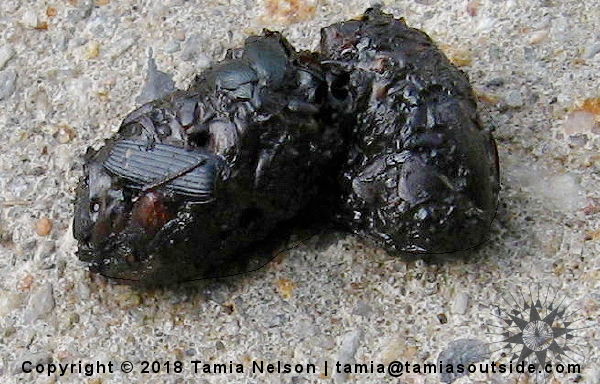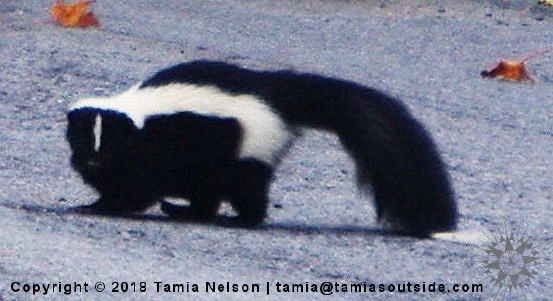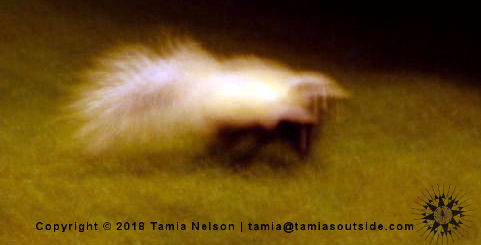Who woulda thought that a photo of skunk scat would be such a draw? One thing is certain, though. Skunks aren’t only good neighbors—they eat the grubs of nuisance insects—but they’re also cute.
______________________________
by Tamia Nelson | April 9, 2018
Not long after I founded this website, I published a short article about wildlife scat and included a photo of skunk scat. Three skunks live in the area, and I’ve met them all at one time or another. Sometimes all three of them will dine on seed left behind at the bird table outside my office window. Their bright white stripes stand out in the moonlight, and each skunk is easily distinguished from the others by the unique shapes of their white stripes and tails. I’ve become rather fond of Pepé, Pierre, and Big Momma. I’ve crossed paths with them when taking nighttime strolls onto the hillside to get a breath of air before bed. In all the years I’ve lived close to skunks, none has sprayed me with their formidable deterrent. We all give one another elbow room and treat each other with respect.
So where’s the mystery? It’s only this: For years there has been a steady trickle of visitors to Tamia Nelson’s Outside looking for information about skunk scat. I can’t figure why this could be. Are there lots of others like me who like skunks? I really have no idea. But for those of you who find TNO through search engine queries for skunk scat, this is for you:

Turds tell tales, and these are no exception. The skunk who left this calling card clearly dined on beetles, ants, and sunflower seeds. Each segment is about the size of a Vienna sausage which, come to think about it, a skunk would find to be a special treat, even if the preservatives aren’t healthy for anyone, man or beast.
The local skunks leave shallow holes in the lawn after burrowing for grubs, large, pale, succulent sausages that seem to be to skunks what potato chips are to us—you can’t eat just one. If you go outside one morning and find these inverted cone-shaped craters in the lawn, it’s probably a sign that skunks have been helping to keep your yard free of insect pests.
I think Big Mama is the mother of the two other skunks, but Pepé may be her mate:

I caught him just before dawn, on his way back home into the woods across the road. He has a black tail with a white tip. He’s looking back at me, as you can tell by the thin white stripe down the middle of his face. Right after this long shot was snapped, he ran swiftly into the woods.
Mama’s large and authoritarian, while the smaller skunks behave like young kids when she disciplines them. It’s a terrible picture because Big Momma was on her swift early evening commute to the grubby hunting ground. Big Momma is distinguished by a nearly all-white back and upper part of her tail, in addition to her large size.

The nights are still below freezing, and I haven’t seen the skunk family since early winter. They don’t hibernate, but they do have periods of torpor. When they come out of their sleep, I’m sure that they’ll stop by for a visit, and I’ll be happy to greet them.

